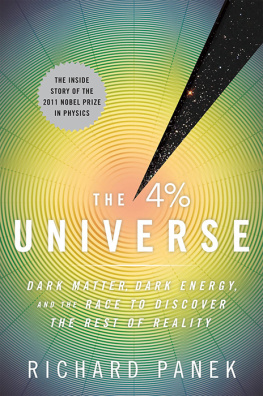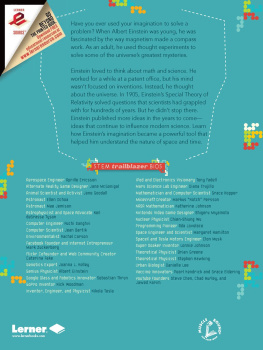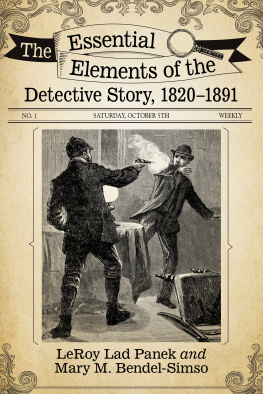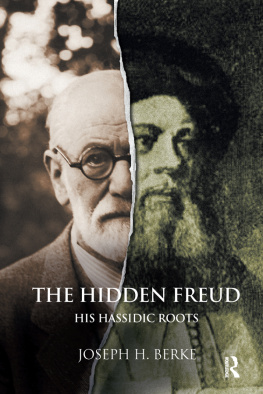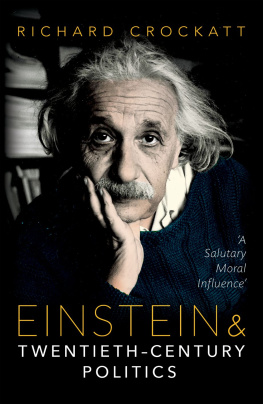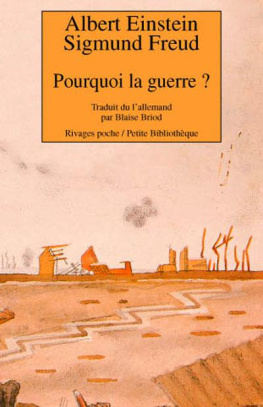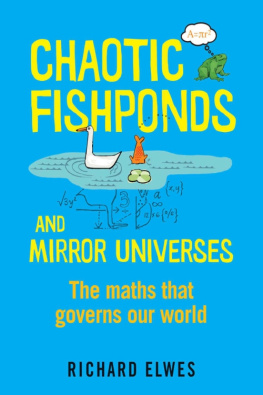Richard Panek - The Invisible Century: Einstein, Freud, and the Search for Hidden Universes
Here you can read online Richard Panek - The Invisible Century: Einstein, Freud, and the Search for Hidden Universes full text of the book (entire story) in english for free. Download pdf and epub, get meaning, cover and reviews about this ebook. year: 2005, publisher: HarperCollins Publishers, genre: Science fiction. Description of the work, (preface) as well as reviews are available. Best literature library LitArk.com created for fans of good reading and offers a wide selection of genres:
Romance novel
Science fiction
Adventure
Detective
Science
History
Home and family
Prose
Art
Politics
Computer
Non-fiction
Religion
Business
Children
Humor
Choose a favorite category and find really read worthwhile books. Enjoy immersion in the world of imagination, feel the emotions of the characters or learn something new for yourself, make an fascinating discovery.

- Book:The Invisible Century: Einstein, Freud, and the Search for Hidden Universes
- Author:
- Publisher:HarperCollins Publishers
- Genre:
- Year:2005
- Rating:4 / 5
- Favourites:Add to favourites
- Your mark:
- 80
- 1
- 2
- 3
- 4
- 5
The Invisible Century: Einstein, Freud, and the Search for Hidden Universes: summary, description and annotation
We offer to read an annotation, description, summary or preface (depends on what the author of the book "The Invisible Century: Einstein, Freud, and the Search for Hidden Universes" wrote himself). If you haven't found the necessary information about the book — write in the comments, we will try to find it.
Richard Panek: author's other books
Who wrote The Invisible Century: Einstein, Freud, and the Search for Hidden Universes? Find out the surname, the name of the author of the book and a list of all author's works by series.
The Invisible Century: Einstein, Freud, and the Search for Hidden Universes — read online for free the complete book (whole text) full work
Below is the text of the book, divided by pages. System saving the place of the last page read, allows you to conveniently read the book "The Invisible Century: Einstein, Freud, and the Search for Hidden Universes" online for free, without having to search again every time where you left off. Put a bookmark, and you can go to the page where you finished reading at any time.
Font size:
Interval:
Bookmark:
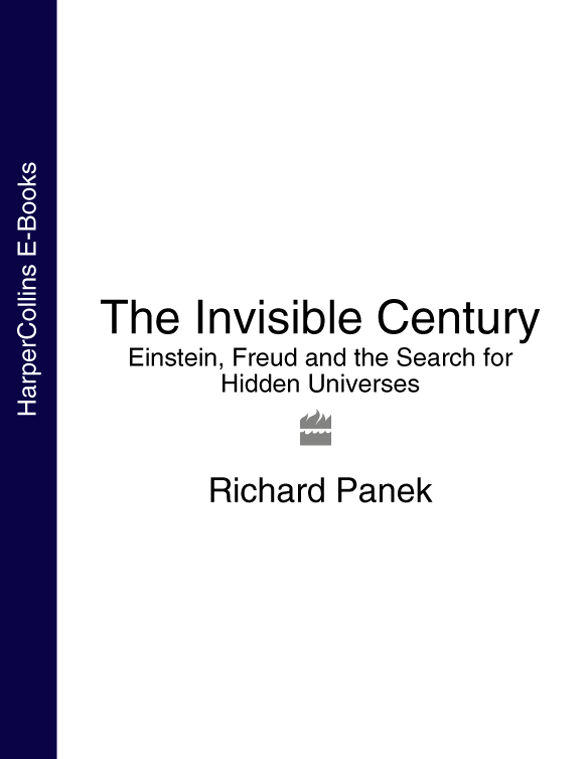
Richard Panek has written on science, especially astronomy, for The New York Times Magazine and Esquire. He is the author of Seeing and Believing: The Story of the Telescope, or How We Found Our Place in the Universe.
Seeing and Believing: The Story of the Telescope,
or How We Found Our Place in the Universe
EINSTEIN, FREUD
AND
THE SEARCH FOR
HIDDEN UNIVERSES

Once again, for Meg Wolitzer, with love
The author would like to thank Dawn Drzal for her help in formulating the proposal for this book, Barbara Grossman for her instant support, Christopher Potter for his early and ongoing enthusiasm, Wendy Wolf for her expert editorial guidance and patience and faith (and patience), Beena Kamlani for her hidden universe of editorial wisdom, Henry Dunow for his agents counsel and perseverance, Gino Segr for his advice on Einstein, Robert Galatzer-Levy for his advice on Freud, the Corporation of Yaddo for its generosity with time and space, Joel Whitebook for his hours of inspiration, and finally, for indulging their father yet one more time, Gabriel and Charlie.
Q: Is the invisible visible?
A: Not to the eye.
from an 1896 interview with
Wilhelm Conrad Rntgen,
the discoverer of the X-ray
They met only once. During the New Years holiday season of 1927, Albert Einstein called on Sigmund Freud, who was staying at the home of one of his sons in Berlin. Einstein, at forty-seven, was the foremost living symbol of the physical sciences, while Freud, at seventy, was his equal in the social sciences, but the evening was hardly a meeting of the minds. When a friend wrote Einstein just a few weeks later suggesting that he allow himself to undergo psychoanalysis, Einstein answered, I regret that I cannot accede to your request, because I should like very much to remain in the darkness of not having been analyzed. Or, as Freud wrote to a friend regarding Einstein immediately after their meeting in Berlin, He understands as much about psychology as I do about physics, so we had a very pleasant talk.
Freud and Einstein shared a native language, German, but their respective professional vocabularies had long since diverged, to the point that they now seemed virtually irreconcilable. Even so, Freud and Einstein had more in common than they might have imagined. Many years earlier, at the beginning of their respective scientific investigations, they both had reached what would prove to be the same pivotal juncture. Each had been exploring one of the foremost problems in his field. Each had found himself confronting an obstacle that had defeated everyone else exploring the problem. In both their cases, this obstacle was the same: a lack of more evidence. Yet rather than retreat from this absence and look elsewhere or concede defeat and stop looking, Einstein and Freud had kept looking anyway.
Looking, after all, was what scientists did. It was what defined the scientific method. It was what had precipitated the Scientific Revolution, some three centuries earlier. In 1610, Galileo Galilei reported that upon looking through a new instrument into the celestial realm he saw forty stars in the Pleiades cluster where previously everyone else had seen only six, five hundred new stars in the constellation of Orion, a congeries of innumerable stars in another stretch of the night sky, and then, around Jupiter, moons. Beginning in 1674, Antonius von Leeuwenhoek reported that upon looking at terrestrial objects through another new instrument he saw upwards of one million living creatures in a drop of water, animals numbering more than there were human beings in the united Netherlands in the white matter on his gums, and then, in the plaque from the mouth of an old man whod never cleaned his teeth, an unbelievably great number of living animalcules, a-swimming more nimbly than any I had ever seen up to this time.
Such discoveries were not without precedent. They came, in fact, at the end of the Age of Discovery. If an explorer of the seas could discover a New World, then why should an explorer of the heavens not discover new worlds? And if those same sea voyages proved that the Earth could house innumerable creatures previously unknown, then why not earth itself or water or flesh?
What was without precedent in the discoveries of Galileo and Leeuwenhoek, however, was the means by which they reached them. Between 1595 and 1609, spectacle makers in the Netherlands had fit combinations of lenses together in two new instruments that performed similar, though distinct, optical tricks. The combination of lenses in one instrument made distant objects appear nearer, the combination in the other made small objects appear larger; and for the first time in history investigators of nature had at their disposal tools that served as an extension of one of the five human senses. As much as the discoveries themselves, what revolutionized science over the course of the seventeenth century was a new means of discovery and what it signified: There is more to the universe than meets the naked eye.
Who knew? After all, these instruments might easily have revealed nothing beyond what we already knew to be there, and what we already knew to be there might easily have been all there was to know. The naked eye alone didnt have to be inadequate as a means of investigating nature; the invention of these instruments didnt have to open two new frontiers. But it was; and they did.
For thousands of years, the number of objects in the heavens had been fixed at six thousand or so. Now, there were more. Since the Creation, or at least since the Flood, the number of kinds of creatures on Earth, however incalculable as a practical matter, had nonetheless been fixed. Now, there were more. There are more things in heaven and earth, Horatio, than are dreamt of in your philosophy: When Shakespeare wrote these words in 1598 or 1599, at the very cusp of the turn of the seventeenth century, he was referring to the understandable assumption among practitioners of what would soon become the old philosophy that much of what was as yet unknown must remain unknown forever, and for the next three hundred years the practitioners of what they themselves came to call the New Philosophy frequently cited it as the last time in history that someone could have written so confidently about civilizations continuing ignorance of, and estrangement from, the universe.
Because now all you had to do was look. Through the telescope you could see farther than with the naked eye alone and, by seeing farther, discover new worlds without. Through the microscope you could see deeper than with the naked eye alone and, by seeing deeper, discover new worlds within. By seeing more than meets the naked eye and then seeing yet more, you could discover more.
How much more? It was a logical question for natural philosophers to ask themselves, and the search for an answer that ensued over the next three centuries was nothing if not logical: a systematic pursuit of the truths of nature to the outermost and innermost realms of the universe, until by the turn of the twentieth century the search had reached the very limits of human perception even with the aid of optical instruments, and investigators of nature had begun to wonder: What now? What if there was no more
Next pageFont size:
Interval:
Bookmark:
Similar books «The Invisible Century: Einstein, Freud, and the Search for Hidden Universes»
Look at similar books to The Invisible Century: Einstein, Freud, and the Search for Hidden Universes. We have selected literature similar in name and meaning in the hope of providing readers with more options to find new, interesting, not yet read works.
Discussion, reviews of the book The Invisible Century: Einstein, Freud, and the Search for Hidden Universes and just readers' own opinions. Leave your comments, write what you think about the work, its meaning or the main characters. Specify what exactly you liked and what you didn't like, and why you think so.


